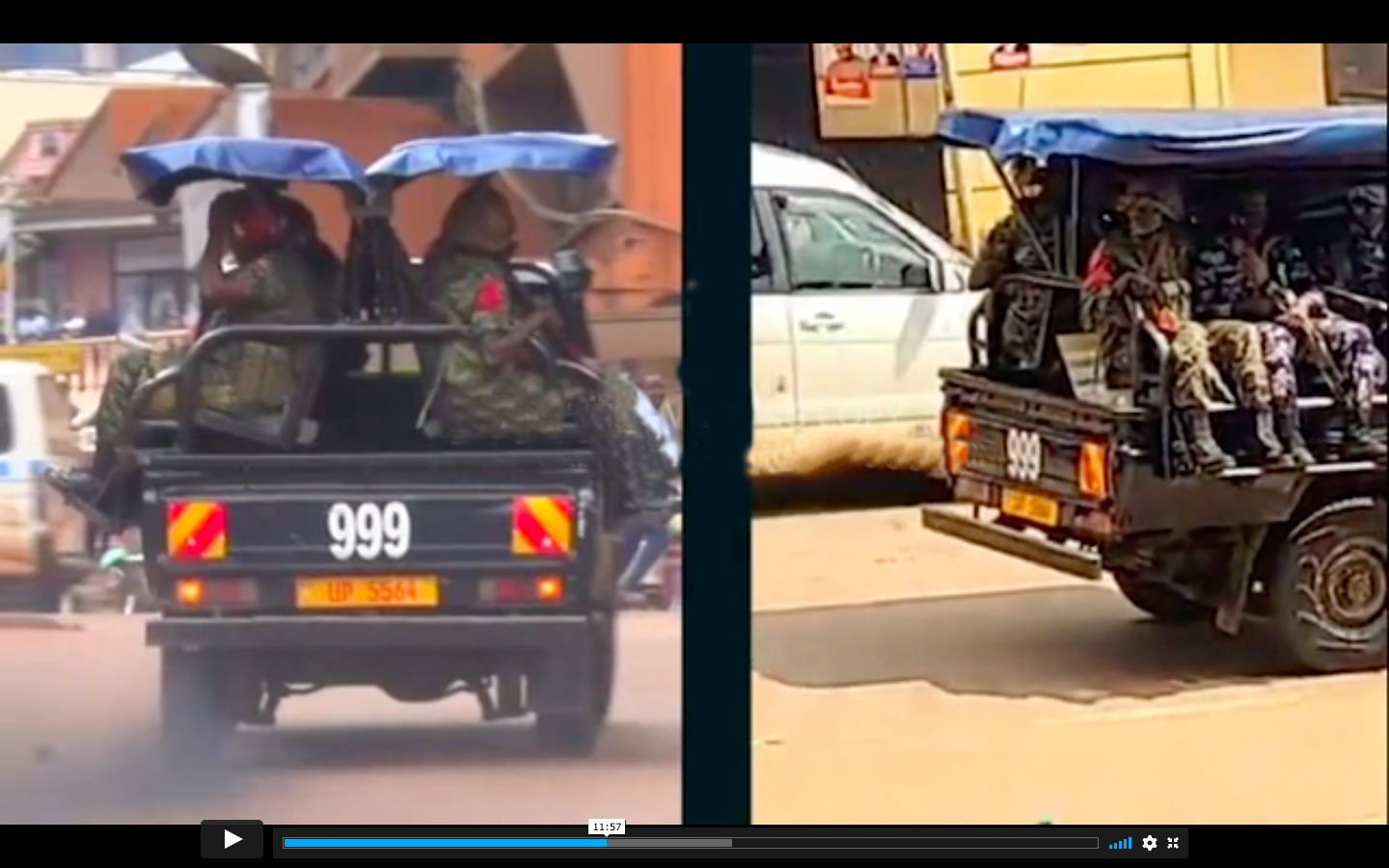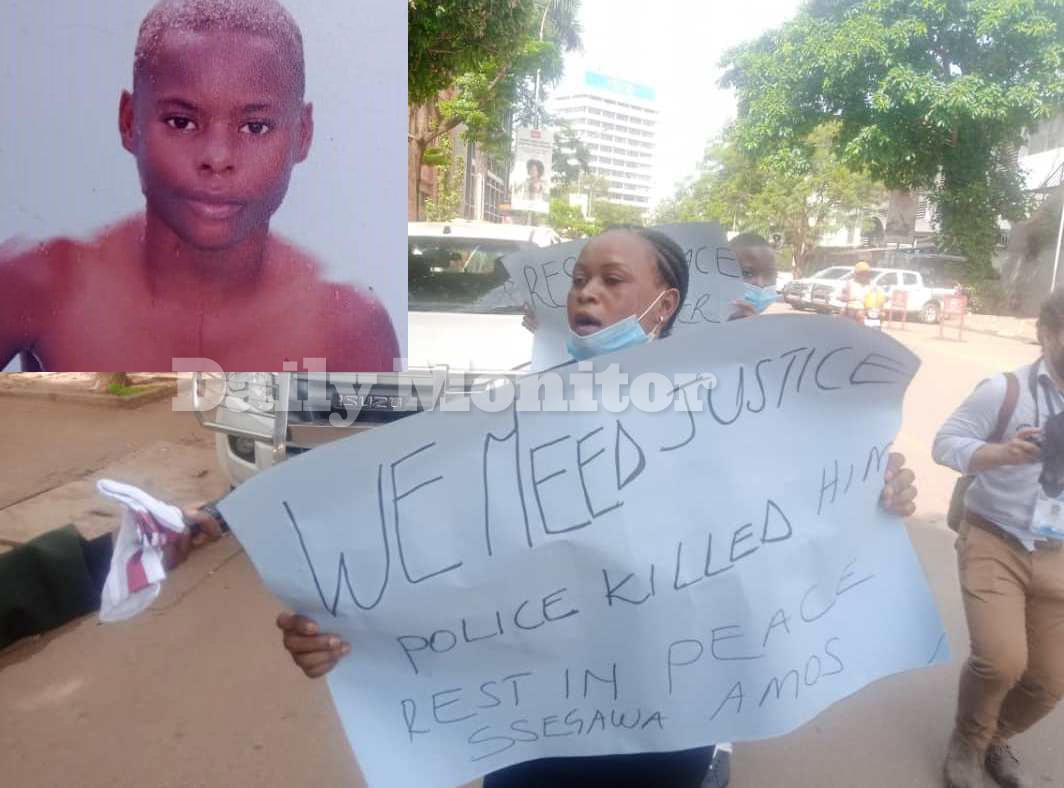Prime
VIDEO: New evidence on Nov city killings emerges

A video grab of a patrol car registration number UP 5564 during the November killings.
What you need to know:
- A forensic analysis of 400 videos shows, among others, that shooters of people on Kampala Road spotted military and field force police uniforms and rode on the back of 999 police patrol vehicle, registration UP 5564
Some of the armed men who shot at and killed alleged rioters on Kampala’s streets last November drove in police patrol pick-up and other state vehicles and brandished AK-47 assault rifles, according to new evidence.
A BBC Africa Eye investigation titled, Three Killings in Kampala, which airs this morning, reveals that the men who allegedly targeted and shot civilians dead on Kampala Road, wore military police and field force police uniforms.
They were captured in multiple videos analysed by the British public broadcaster to have sat on the left back-side of a patrol police pickup, registration UP5564, and emblazoned with number 17 on the sides.
The videos shot by well-wishers from different directions and angles show the patrol car speeding from Bombo Road side, with security personnel on its back shooting indiscriminately as city dwellers scampered for safety.
Among them was Kamuyat Nangobi, 28, a waitress and mother of four. Dressed in a black top and red skirt, a bullet caught her on the back of her head as she sprinted to deliver food to her grandfather, Mr Muslim Musimami, based at E-Towers on Kampala Road.
RELATED
She fell face-down and the plates she was carrying crushed on the hot bitumen surface and her mobile phone handset fell close to her frontally outstretched arm.
Kamuyat became a poster-child of the November bloodletting, which the state says in total claimed 54 lives over two days, when a picture of her body lying in a pool of blood by the roadside widely circulated on social media on day one of the madness.
The riots were ignited by the arrest of then National Unity Platform (NUP) presidential candidate Robert Kyagulanyi, alias Bobi Wine, while on a campaign trail in eastern Uganda.
The BBC Africa Eye carried out forensic analysis of 400 videos shot on mobile phone handsets and spoke to 30 witnesses who, the broadcaster, reported corroborated accounts that some of the victims were killed in cold-blood.
A leaked copy of the government’s investigations report on the killings, which it produced and exclusively circulated to western donor countries, and whose findings this newspaper partially published a fortnight ago, showed only 13 of the 54 victims had anything to do with the violent protests.

The government told BBC Africa Eye investigators that the inquiry into the killings was complete and that findings had been submitted to Parliament.
In the aftermath of the admission, Uganda Law Society as well as human rights defenders categorised the lives lost last November as acts of “extra-judicial killings” and demanded the government name and prosecute the perpetrators.
The government is yet to publicly identify the shooters, if it ever will, and both the army and police continue to point at each other for answers on accountability over the killings amid claims investigations into the matter are ongoing even after CID Director Grace Akullo signed off the report of the official inquiries way back in December.
The videos analysed by BBC Eye suggest that the person who shot Kamuyat was one of four armed men seated on the left side of the police pickup truck. That crew was linked to the shooting of seven other people within the shot stretch from E-Tower to the turn off Kampala Road to CPS.
The images show that two people were shot at Little Bee Restaurant, but they survived after Uganda Red Cross and other volunteers evacuated them into an ambulance and onwards to Mulago National Referral Hospital.
John Amera, 31, a father of two who worked at a phone shop near Shell Capital, was fatally shot in the chest as he hid in a shop.
23-year-old Abbas Kalule, an electronics shop attendant across the street from Amera, was shot in the upper left leg and reportedly died at hospital after four days.
Septuagenarian and former academic John Kittobbe, who was reportedly in the city centre to exchange money, was shot in the neck at the door of Mabirizi Complex facing Kampala Road.
Another passer-by took a bullet on the lower back at the eastern entrance to Mabirizi Complex, suggesting he was shot at after the police patrol pick-up turned to head to CPS.
According to the BBC Africa Eye investigation, the videos show no link between the people shot and the riots, suggesting that they were killed in cold blood.
Similar drive-by shootings happened about 7 kilometres away, in Banda, on the Jinja highway.
According to videos analysed by the BBC, the shooters were driving at a high speed in government vehicles including a Prado.
Shakira Nyemera, who had a two-weeks-old baby at the time, and her neighbour Shamim Nabirye, pregnant with triplets were shot at by the roadside, but survived.
Ms Nyemera who was returning from a shop had joined other onlookers when a bullet hit her and Ms Nabirye, who was standing close to her.

Ms Nyemera said her wounds appear to have healed from the outside, but she still feels pangs inside her body.
The third shooting incident happened at Cornerstone Plaza, near Usafi Taxi Park. Arnold Ssegawa, a 15-year-old student of Lubiri High School (Buloba Campus), was shot in the mouth by soldiers, whom witnesses said targeted civilians as a game.
These security forces were reportedly on a military pick-up they had descended from Mengo, the hill on the western side of Kampala Central Business District.
His mother, Hajjarah Nakitto, is the only one of the various families who lost their loved ones, who is pursuing justice in the courts of law.
“They were aiming directly at the people and shooting at them. It was the military that killed my son. The car drove off, still shooting. They have killed innocent people like my child, and I am here suffering,” she says in the video.
Daily Monitor published the first substantive account of the November killings witnesses and the circumstances in an incisive series titled: November riots: The lives we lost.
The BBC Africa Eye Investigation, which came four months after this newspaper’s ground breaking investigations, builds on the findings and sheds new light in attempting to pinpoint the actual killers.




